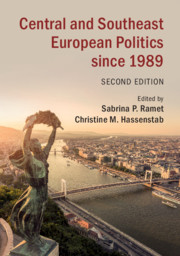Book contents
- Central and Southeast European Politics since 1989
- Central and Southeast European Politics since 1989
- Copyright page
- Dedication
- Contents
- Figures and Maps
- Tables
- Contributors
- Preface
- Glossary
- Guide to the Pronunciation of Central and Southeast European Words
- Additional material
- Part One Introduction
- Part Two Issues
- Part Three Central Europe
- Part Four Yugoslav Successor States
- Part Five Southeastern Europe
- Part Six Present and Future Challenges
- 19 Regional Security and Regional Relations
- 20 The European Union and Democratization in Central and Southeastern Europe since 1989
- 21 Conclusion – Adapting to the Twenty-First Century: Lessons, Progress, and Regression
- Index
- References
19 - Regional Security and Regional Relations
from Part Six - Present and Future Challenges
Published online by Cambridge University Press: 16 September 2019
- Central and Southeast European Politics since 1989
- Central and Southeast European Politics since 1989
- Copyright page
- Dedication
- Contents
- Figures and Maps
- Tables
- Contributors
- Preface
- Glossary
- Guide to the Pronunciation of Central and Southeast European Words
- Additional material
- Part One Introduction
- Part Two Issues
- Part Three Central Europe
- Part Four Yugoslav Successor States
- Part Five Southeastern Europe
- Part Six Present and Future Challenges
- 19 Regional Security and Regional Relations
- 20 The European Union and Democratization in Central and Southeastern Europe since 1989
- 21 Conclusion – Adapting to the Twenty-First Century: Lessons, Progress, and Regression
- Index
- References
Summary
After the seemingly successful reordering of security in Central and Southeastern Europe after the 1989 revolutions, the conclusion of the Yugoslav wars of secession, and NATO and European Union (EU) enlargement, hard security considerations have catapulted back onto the region’s policy agenda. The EU’s Eastern Partnership, intended as a benign project to assist six post-Soviet states between the EU and Russia, instead came to threaten Russian security sensitivities. The Russian annexation of Crimea and the fomenting of violence in Ukraine’s southeast since 2014 have obliged Euro-Atlantic states and institutions to be more proactive toward securing their eastern flanks, including to the point of making new military deployments in the countries neighboring Russia. Despite this turn in European security practice, the chapter also argues that the many regional cooperation formations created since 1989 continue to provide a significant if subtle positive impact both on regional relations and more widely on those across Europe. The chapter, nevertheless, details how the most prominent initiative, Visegrad, has turned from having been a leading proponent of European values in the 1990s and an instrument for Euro-Atlantic integration to a challenger of EU values through its successful but controversial handling of the so-called migrant crisis that erupted in 2015.
- Type
- Chapter
- Information
- Central and Southeast European Politics since 1989 , pp. 509 - 538Publisher: Cambridge University PressPrint publication year: 2019



